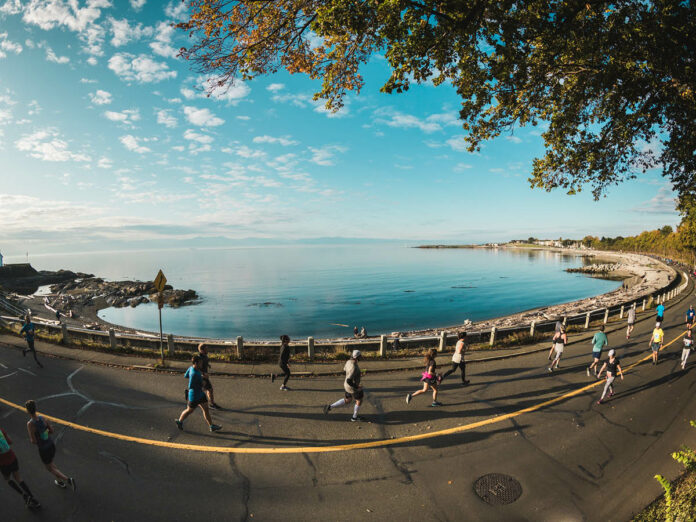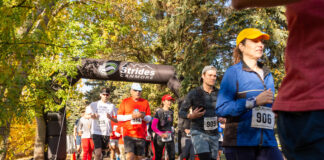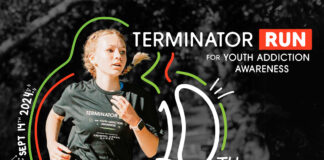
Races should be in full swing now with athletes of all abilities setting goals and celebrating their PB’s. Summer training clinics are usually gearing up for the busy fall season, and the 2020 Tokyo Olympics would have come and gone. But in March the world changed and sport as we know it was obliterated from the calendar.
Races small and large are cancelled and now, halfway through 2020, we don’t know what the future holds for this vibrant industry. The fallout from COVID-19 has affected the race industry in such a way that many smaller events may not recover. Others will – but in what capacity?
IMPACT Magazine has been talking to many industry professionals about how the pandemic has affected their races, how they have adapted and changed gears to survive, and what effect this has had on participants, partners and charities.

“COVID has decimated the event industry. Events were the first thing to get shut down and we will be the last to come back,” says Kirsten Fleming, Executive Director of the Scotiabank Calgary Marathon, summing up the situation. “Each organization is hurting to varying degrees based on where in the planning cycle it was for its biggest event.”

The Scotiabank Calgary Marathon is one of seven events Run Calgary stages. With their events staggered throughout the year, they were hard hit early on but their fall events will partially recover. “We had incurred the majority of the costs for our spring season and some of the sponsorship but only half our registration revenue. For the fall events, we hadn’t incurred many expenses and even less revenue and no sponsorship,” Fleming adds.

Race directors across the board are in agreement about the loss of revenue, particularly as a lot of the spring races had already incurred major costs such as equipment rental, permits, registration fees, and participant shirts and medals. “Like a lot of businesses in our industry, we operate on very slim margins, so it was definitely a ‘burning platform’ moment for us when the crisis hit. Seventy-five per cent of our operating revenue traditionally comes from entry fees,” says Charlotte Brookes, National Event Director for Canada Running Series (CRS). The series consists of nine races across the country from February to October, including the Scotiabank Toronto Waterfront Marathon, one of the latest victims of the pandemic.

Brian Gallant from Sinister Sports organizes some of the most extreme events in the country – Sinister 7 Ultra, Canadian Death Race, Black Spur Ultra and Run the Rocks. These events in British Columbia and Alberta are very popular among endurance athletes but virtually came to a standstill when the pandemic hit. “We will have a six-figure net loss this year. We had to cancel two of our biggest events and our two smaller events are still pending. We don’t even know if we can open registration for next year. I normally hire a dozen part-time and 40-50 temporary staff to augment my crew; none of that will be happening.”
One of the longest running marathons in Canada, the Saskatchewan Marathon, was slated for May 31. Its cancellation drastically cut into their financials, says race director Kim Ali. “We anticipate that the Saskatoon Road Runners, who own the race, will subsidize the race in the neighbourhood of $15,000. These funds would come from their rainy-day fund.”
Other multisport events will see bigger losses. The TransRockies Race Series stage multiple events in Canada and the US and cancelled all of their events except the Moab, Utah race in October. “Given that all funds received for this year become a liability, we will see a loss of around $300-$400,000 as a result of overhead and operating costs already incurred preparing for the 2020 season,” explains co-race director Aaron McConnell.
The GoodLife Fitness Victoria Marathon, held on Thanksgiving Weekend in October, cancelled in June, but earlier than that they decided to err on the side of caution. “Our event was eight months out when COVID started, making us question whether we were going to have to cancel, so we scaled back on marketing and signed off on any supplier contracts which reduced our risk,” says Cathy Noel, General Manager/Race Director. “We were lucky that we were able to postpone our shirt delivery which is our largest line item.”
The TC10K in Victoria was not so fortunate, cancelling six weeks out from the April 26 race. “Unfortunately we had incurred most of our expenses and commitments so this will greatly affect our bottom-line next year, “ says executive director Keith Bridge.
Cheryl Lowery, race director of Be There Races in Calgary, has six races throughout the year and wasn’t feeling optimistic that any would survive. However, with restrictions slowly being lifted in Alberta, she announced in July that three of her spring races will be re-scheduled. These will be Tri for Evan on August 8, Sprung Trio 5/10/15 km on August 16th and Sprung Trio Trail on August 24th. “I am renaming them Sprung Trio from Spring! We’re pretty happy to be at least a little bit back in business.” Lowery is hoping that the re-scheduled K-100 can still happen on September 12th.
It isn’t just races who have suffered loss of revenue. Race Day Timing – who time over 100 events in British Columbia and Alberta annually – has lost half a million dollars. Owner Mark Nelson’s busy season starts in April. “November to March is our quiet time when we typically work on other projects and prepare for the season ahead, so we already had four months of lean time when the pandemic hit.” With a real estate business to fall back on he decided to ride out the pandemic. “I am fortunate to have that; others don’t.”
Should Race Events Refund, Defer or Go Virtual?
One of the biggest headaches race directors face with cancellations is the refund issue. Do they refund, (even though many races have a clear no-refund policy), defer their entries or go virtual? All over the globe when events started to cancel, registrants demanded their money back. Race insurance does not cover refunds in a pandemic, so for many events it was a do or die situation.
Victoria and Saskatchewan gave options – refund, defer, donate to charity or (in Saskatchewan’s case) switch to virtual. On Vancouver Island the Oak Bay Half Marathon gave a refund or defer option, the Island Race Series a 75 per cent refund (they cancelled three of the eight race series) and Finlayson Arm 28 km / 50 km / 100 km gave 100 per cent deferrals. Tom Bamford, race director of Platinum Racing recently cancelled IRONMAN 70.3 in Calgary. “But we are building deferral policies that provide our events company a lifeline to 2021.”
It’s in times of crisis that race directors have to get creative, and when it comes to going virtual some have gone above and beyond. When the Banff Marathon was cancelled, race director Paul Regensburg offered all registrants a two-week window to run a virtual race in the marathon, half marathon or 10 km distance. All received a race bib, results, a finisher’s certificate and a shirt and medal. Never did he expect how it would take off.

“The virtual run surpassed our expectations with over 1,700 registrants from 30 countries around the world. The downloadable race bib featuring icons specific to Banff National Park was a hit and many of the participants wore it for their run.” They featured a photo contest on Instagram with over 1,200 submissions from around the world with prizes such as trips to Banff and the Yukon. The success of it got him thinking about next year. “I could really see us going forward with the real event and sort of a complementary virtual event happening side-by-side, so people who can’t make it to Banff that year can still feel like they were there, feel like they were a part of it.” To further encourage participation in 2021 and 2022 he is offering 50 per cent off race entries.
One of the first events to go virtual was the Women’s Fun Run in Red Deer in May. Race director Val Jensen announced six weeks out that they would re-imagine the event, making it clear that the community could register and commit to be active on May 9, when the run was slated to happen. Refunds were offered but 60 per cent of registrants donated their fee to the official charity, The Mustard Seed. The community, including sponsors, local businesses and school boards, got behind the event, Jensen explains. “Over 1,600 people signed up for the re-imagined event and we had a very successful package pick-up on May 8th. Participants were genuinely thrilled to see our event moving forward and we received fantastic praise and smiles from all! Event day saw walkers, runners, bike riders, roller bladers and strollers with little ones being active.” The event raised $51,000 for The Mustard Seed lunch program.
The Victoria Goddess Run has year-round virtual events, so switching to virtual was a no-brainer for race director Cathy Noel. “We moved the Goddess Run to a full virtual format and had over 750 participants. We have been doing virtual events throughout the year and in conjunction with the live June event for three years, so the process was known.”
Offering challenges is an innovative way to keep people engaged while adding some fun into the mix. When the Tour de Victoria cancelled they decided to host an eight-week #ridelocal challenge for the summer. “These are super fun challenges that cyclists of all ages and abilities can complete. There is no charge for these challenges – we just want to spread the joy of cycling in the absence of us hosting an event this year,” says race director Seamus McGrath. The GoodLife Fitness Victoria Marathon is offering a similar challenge through its Facebook online training group – weekly and monthly challenges using the hashtag #runVictoriachallenge.

TransRockies Race Series has also created digital challenges: “For the most part these are not creating revenue, but rather are being used to maintain engagement with our participants and crew,” says McConnell. The verdict on whether virtual runs are moneymakers does differ depending on whom we talk to. While Sinister Sports has hosted virtual events, Gallant comments: “The uptake has not been great. What I am finding, and what event directors that I’m talking to are saying, is that virtual events and online sales are only bringing in about five per cent of the regular revenue.” Cory Freedman, race director of the Toronto Women’s Run Series, has transitioned her three races to virtual: “We are cautiously optimistic that we will be able to generate 50 per cent of our projected revenue.”
Run Calgary has gone all out with six virtual experiences as part of the 2020 Run Calgary Virtual Running Festival. “We invited registered participants to join us in a virtual Scotiabank Calgary Marathon Race which runs until September 27th, and we have five other virtual events that support local charities and small businesses as well as Run Calgary, which is a not-for-profit,” explains Fleming.
Pivoting to the virtual world has been made easier with companies such as Race Roster offering multiple platforms to assist event organizers. When the coronavirus halted so many events the organization immediately sprung to action helping races large and small with refunds, deferrals and developing their RunKeeper® app for participants who wanted to record their virtual runs online. “Race Roster spent the spring supporting event organizers who were faced with the difficult challenge of cancelling or postponing their events,” explains Britt Shannon, Director of Brand Engagement. “Simultaneously our team has been focused on advancing technology for virtual event experiences, helping the running community connect while apart. In this season of social distancing, the popularity of running is on the rise, and we look forward to seeing what that means for in-person races when they return.”
Charitable Support From The Race Industry
While we mourn the temporary loss of events, it is the charities who are really suffering through this pandemic. Races provide a valuable revenue stream for charities, bringing in hundreds and thousands of dollars annually. For those events offering the virtual option, participants are encouraged to continue to fundraise. But how effective is this? There are definite advantages.
“Many of our charities in the Canada Running Series are smaller, community-based, and are now in need more than ever. They have hugely appreciated our move into the virtual space so that our fundraising initiatives can continue. For some, they are actually enjoying the fact that their supporters can fundraise and do their virtual run anytime, anywhere,” says Brookes.
Fleming agrees that charities can benefit: “Now all of the charity supporters who might not identify as a runner, don’t want to get up early, can’t make it to a race due to living rurally or having a conflict, or hate crowds, can participate virtually and walk or run a distance over a period of time, wherever they might be. It broadens the reach and appeal.”
Ensuring the event-charity relationship remains strong has never been so important. “We continue to work with our Victoria Marathon charities and are setting up a fundraising platform under the marathon umbrella for them to use this year,” says Noel.
“We are hosting monthly brainstorming webinars with our Run Calgary charities, working with them to come up with creative ways to engage their audiences. We are strengthening our relationships with our charity partners during this time,” adds Fleming.
The smaller events may not fare as well, particularly for those who deferred. “Because of the 100 per cent deferrals going to next year, a massive drop in the donation to our charity, Island Kids Cancer Association is likely,” says Myke LaBelle, race director of the Finlayson Arm Ultra Races.

Gallant says he will see a drop in donations in his four races in the Sinister Series, while Freedman from the Toronto Women’s Run Series is more optimistic: “Fundraising is pretty close to on par with other years for some of the races.” Ali from the Saskatchewan Marathon also confirmed their charities will receive the same as prior years.
One runner has ensured his charity of choice won’t suffer. Every year Victoria resident Al Ferraby runs his ‘21 for 21’ campaign at the Oak Bay Half Marathon, raising funds for one of the official charities – CFAX Santas Anonymous. This year he ran the course on his own and raised $31,000.
Charities must also innovate new ways to fundraise. The MS Society of Canada holds a series of fundraising events each summer across the country, and even though this hasn’t been possible this year, there are other ways they are encouraging participation. “Through online events and initiatives like #WeChallengeMS and the Virtual MS Walk, where we saw 11,000 plus people tune in and participate in our live-stream event, the MS Society has been able to continue providing essential support, advocacy and resources for Canadians living with MS and their families,” says Becky Mitts, Senior Director, Events. The challenge continued into July and August with the Virtual MS Bike event.
Connecting with Race and Event Sponsors
Sponsor engagement is key when it comes to running a successful event. If an event is postponed or cancelled organizers need to communicate effectively and efficiently with sponsors and partners to maintain their trust and good relations. With so many events being cancelled sponsors could lose valuable exposure to their target market. Sponsors on the whole have been very supportive of the race industry during this crisis with many rolling over their agreements to 2021. For those switching to virtual runs it means sponsors will continue to receive the exposure.
Fleming says that in some cases going virtual has made relationships stronger. “We have tried to create value in the digital space and ensure sponsors are getting the recognition they deserve for their years of support, and the brand awareness they paid for in this calendar year.” Brookes concurs: “We are working together as partners to offer many opportunities through our virtual races and various digital platforms. Most of our partners have been with us for a while and are taking a long-term approach to keep us and their goals in place.”
“Sponsors are very supportive of actions to pivot and mitigate the situation. None have indicated that they will decline for next year, and no sponsorship dollars were returned. Some had not paid in full but provided support in other ways. Most of our sponsors appear to be in good shape from a business perspective, but time will tell,” says Ali.
The Tour de Victoria is grateful for the full support of its presenting sponsor. “Scotiabank has honoured their full sponsorship commitment for 2020 and is remaining on board for 2021. It is their support that is enabling us to survive this year, and continue into next year,” says McGrath.
The Economic Impact From COVID-19
For the larger events that are destination races, the impact of COVID-19 has been huge. The GoodLife Fitness Victoria Marathon regularly undertakes economic studies, and from a tourism perspective the impact over Thanksgiving weekend from hotel stays, restaurant meals and shopping is $12 million.
The Tour de Victoria, usually held in August, is a big economic driver, explains McGrath. “The event attracts approximately 1,400 participants who come from out of town and spend a few days enjoying the world class cycling found on this beautiful island.” Similarly, the Oak Bay Half Marathon attracts 1,500 participants from Vancouver Island, Vancouver and beyond. Ironically, the race partnered with Oak Bay Tourism this year to jointly market the event and at the time of the race cancellation numbers were higher than previous years.

Despite the success of the Virtual Banff Marathon, tourism in the popular rocky mountain town has been devastating says Regensburg. Bamford from Platinum Racing comments it will affect his local communities by $2 million. Gallant from Sinister Sports is in the same position: “For a multi-day race, our studies show that each racer brings two people with them, on average, and together they spend just over $1,200 in the area during their stay. For our largest event, that’s $1.9 million.”
Can Races Recover or Regenerate?
Looking forward, the big question is: will the race industry recover? And if so, when, and what will the race climate look like?
“There is so much uncertainty for the future. We don’t know if and when races will happen in 2021,” says Steve Fleck, professional race announcer and commentator on endurance sports. Fleck has been at the forefront of the industry during the pandemic offering advice and providing resources for race directors. “This year has been a wipeout for many sports. For example, the window of opportunity for cycling and triathlon is May to October. Now that is gone for 2020.” He foresees a smaller race format next year with mass participation events just not happening. “Revenue is participant driven by two million Canadians putting on a race bib – that is one billion dollars in economic impact. Mid to large groups from 500 to 5,000 may not be able to get together anymore. We could see races starting in waves and with a time trial format.”

Gallant feels that if events cannot resume in the spring, organizations will close permanently. “If that is the case, I predict 25-50 per cent of the medium to large events out there will shut down by next summer. Most of our racers are understanding, but it will take us years to get back to where we were.” “If we can’t hold in-person events in 2021 and we aren’t able to access further relief, it is grim,” Fleming says. “We need events in 2021 and we need participants to support them like never before.”
In response to the crisis in the endurance event industry Fleck, Gallant and Fleming co-founded a new organization – the Canadian Endurance Sport Alliance (CESA) – which has the goal of bringing together event organizers and service providers to address the concerns of the endurance industry. Stressing the need that endurance events are strong economic drivers, CESA hopes to convey to the federal government that the industry does warrant support.
Sport organizations across the country are offering guidelines and resources for event planners as part of regional return to sport planning. All are aware that the pandemic has and will change how events are operated for the conceivable future. Brian McCalder, president and CEO of BC Athletics, recognizes that some clubs and events won’t survive. “Events that do manage to survive will have to change how they operate to protect the health of our participants, volunteers, officials, and communities until a vaccine is found.”

There is a feeling in the industry that when events do come back – whether large or small – participants will be eager to get back and events could see a resurgence. “Our hope is that with all of the cancellations this year there will be pent up demand for racing next year and our numbers will be stronger than ever,” says Nick Walker, race director for the Oak Bay Half Marathon.
Sport builds community and with the loss of events, that community feeling has been sorely missed over the last few months. “But sport is resilient,” McCalder adds. “While our operations will be forced to change and adapt, people will continue to get out every day to run and train, and when it is it finally deemed safe for everyone, we’ll come back and be even stronger for it.”
It is this sense of optimism that is keeping race directors and event planners focused during this crisis. By creating ways to engage participants, charities and partners the industry will re-bound; it is just a matter of when.
Lead image by Matt Cecill
 IMPACT Magazine’s Special Summer Edition
IMPACT Magazine’s Special Summer Edition
This has not been a regular summer, and this is not a regular edition of IMPACT Magazine. In fact, it is an unprecedented issue that comes to you as a result of true grit and community support.















